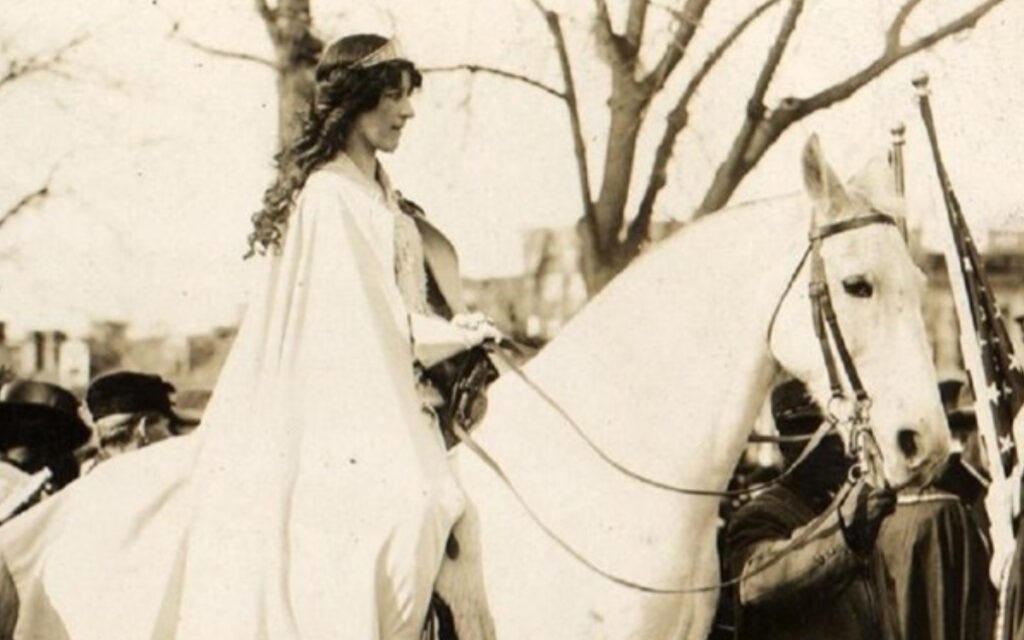My Latest Scribble examines the history of the woman's vote and its potential impact for Kamala Harris
Women's efforts to obtain the vote was the beginning of a struggle for a greater role in democratic society.
Making history in Election 2024: The women’s vote.
by Dave Redekop
October 29, 2024 | 5 min read
Vice President Kamala Harris has also made nods to the history of the women’s movement. Pictured: Suffragette leader Inez Milholland. Photo Credit: Library of Congress.
Vice President Kamala Harris sits on the precipice of history. The role of the women’s vote in the oncoming U.S. presidential election deserves some attention. The first female vice president hopes to become president after the Nov. 5 votes are tabulated. Her success will depend on several factors including her support from fellow women. The road to Harris’s potential ascendancy has been long for the nation and the millions of women who will decide this election.
HISTORY
On Nov. 2 1920, about 30 million Americans voted in the presidential election choosing either Republican Warren G. Harding or Democrat James Cox. Unlike any previous federal election, the nineteenth amendment had just been ratified giving women the nationwide right to vote. Harris or former president Donald Trump will make history if they win. In part one of a two-part series, this article discusses how Harris would break precedent and what has led to this moment.
Sharon McMahon has recently written a book titled, The Small and the Mighty. Relying on an interview she held with Lillian Cunningham on her podcast, Presidential, this article will piece together a story about women’s efforts to secure the vote and how that could finally result in a woman attaining the highest office in the land. McMahon began her interview with Cunningham regretfully noting that many issues important to women nationwide had not yet been addressed, that most of the highest offices are still held by men and that women remain underrepresented in government. These complaints often surface when writers talk about the struggle for women to achieve power. Telling the story about how women received the vote may be more interesting.
Temperance and suffrage were two movements that spoke to the problem of men’s irresponsibility and women’s inability to confront it. Too many men were taking their week’s wages and spending it at the local tavern or saloon, coming home drunk and abusing their wives and children. The only way women could protect themselves and their children was to try and grab political power for themselves. The most sensible way to do that was to gain the vote. For decades women like Susan B. Anthony and Elizabeth Cady Stanton defined the effort to help women acquire political power. But they both passed away in the early 1900s and a rising crescendo for the women’s vote occurred in the early 1910s leading up to World War One. At that point, as McMahon explained, the suffragists had focused on getting women the vote at the state level. Some Western states had consented. One of the new leaders who emerged, Alice Paul, wanted a constitutional amendment to give women the vote nationwide. Besides Paul, another woman who played a prominent role was Inez Milholland.
Milholland was raised in a wealthy, and surprisingly progressive family. McMahon describes her as intelligent, strong-minded, and independent. Inez ended up at Vassar College in Poughkeepsie, New York. Founded in 1861, it became the second degree-granting institution of higher education for women in the United States. Milholland studied law because she wanted to work for justice. She liked to push things in her personal life and her professional life. She even bought a car at a time when that was viewed as too complicated for women. She also happened to be a good public speaker and very, very attractive as McMahon reports. She made suffrage sexy, something no other woman had been able to do or had even attempted. She changed the paradigm from women being seen as scolding teetotalers to those who could be fun, appealing, and interesting. They sent her on a big speaking tour to get women in the West to vote against Woodrow Wilson who expressed great reluctance to allow any kind of suffrage conversation.
Wilson won, nonetheless, and on the day before his Inauguration in 1913, a big suffrage parade gathered on Pennsylvania Avenue. Wearing a costume not unlike Wonder Woman, Inez rode a horse named Grey Dawn. Amongst a huge multitude, the largely male crowd surged on the women and physically assaulted them, yelling at them and even burning them with cigarettes. The event deteriorates further with women continuously being transported to the hospital for hours and the US Calvary having to intervene to bring order. Wilson travelled the same route the next day and began his presidency opposed to women’s suffrage. By 1918 that has all changed. Why?
McMahon believes that World War One and women’s service changed his mind. A group of women called the Hello Girls gained special attention. As telephone operators (this author’s mom was a telephone operator from 1949-1986 in Fort Erie), they made a huge difference in America’s contribution to World War One. Serving in France on the frontlines, they often did their job wearing gas masks. Wilson realized that women cannot be asked to serve their country, put their lives at risk and then have their right to vote denied. In 1920 the ratification of the 19th Amendment occurred, but the story does not end there. The fight had only been joined.
BEYOND SUFFRAGE
The work for women continued. They had to get all women the vote, and then work to get more women elected. There were highlights. In 1968 Shirley Chisholm became the first black woman elected to Congress and, in 1972, the first woman to run for the Democratic Party’s presidential nomination. Women served in the Cabinet, moved into Congressional leadership, and gained increasing power in the military. In 2016 the first woman to head a national ticket (Hillary Clinton) in US political history lost her bid to become president. But in 2020 the first woman to be vice-president ascended to the second highest office and in 2024 seeks to become the president. Even if Harris wins, statistics for women in political office lag. Despite the number of women attending college, becoming doctors, or holding prestigious positions in business and academia, only 25 of the 100 senators in the US Congress are women. Only about 125 sit in the House of Representatives out of 435.
When asked to explain the delay, McMahon explains and then describes where women are today.
“Well, some of it has to do with how large and diverse the United States is. So, these sort of divergent viewpoints that come from a diverse populace create the conditions under which it’s difficult to build consensus about something. And then additionally, our political system is, the framers built it this way, it’s intentionally difficult to change. It’s slanted towards stability and away from flexibility. And in some ways, that has been good. It has allowed the United States to have a stable democracy for hundreds of years. Our government doesn’t collapse all the time like it does in some other systems that are more flexible, but change requires flexibility, right?” McMahon then asserts that women have made progress, but it is slow.
HARRIS’S NODS TO THE SUFFRAGETTES
As for Harris, McMahon believes that she understands her place in the arc of history. Harris herself said in 2020 while running for vice-president, “(Let’s remember) All the women who have worked to secure and protect the right to vote for over a century, 100 years ago with the 19th Amendment, 55 years ago with the Voting Rights Act, and now in 2020 with a new generation of women in our country who cast their ballots and continued the fight for their fundamental right to vote and be heard.”
The vice president has also made other nods to the history of the women’s movement. Her campaign logo is similar to Shirley Chisholm’s in 1972. She wore a white pantsuit in her first appearance after being elected with Joe Biden. Counter-intuitively she has not always leaned as heavily into language about being the first female president. McMahon believes Harris knows women understand the implications and men don’t want it shoved in their faces. Recent polls reveal a large gender gap favouring Harris among women and Trump among men. She will likely need about 60% of the women’s vote to win. McMahon thinks Harris will celebrate her womanhood if she wins. So will the millions of women who have waited for this moment.
WHAT IF SHE WINS? HOW MUCH POWER WILL WOMEN HAVE?
McMahon does not see a tidal wave of power for women because Harris wins. It will matter and be a step forward in the march of progress. Achieving the presidency for women will represent an important milestone for women in their quest for equality. Kamala Harris could forever change how Americans see the presidency.
The second part of this article will examine how Trump will make history if he reclaims the office he left four years ago under tumultuous conditions.
This article first appeared in the Niagara Independent on October 25, 2024
Dave Redekop is a retired elementary resource teacher who worked part-time as a registrar at the St. Catharines Courthouse until being appointed Executive Director at Redeemer Bible Church in October 2023. He has worked on political campaigns since high school and attended university in South Carolina for five years, earning a Master’s in American History with a specialization in Civil Rights. Dave loves reading biographies.





